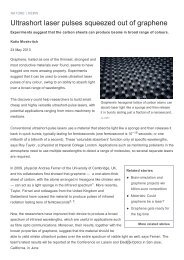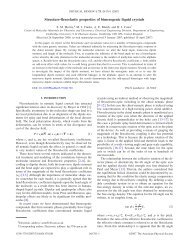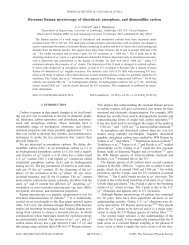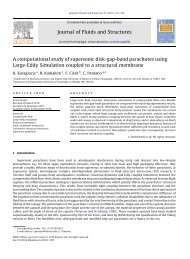CIKC Brochure 201003_5b - University of Cambridge
CIKC Brochure 201003_5b - University of Cambridge
CIKC Brochure 201003_5b - University of Cambridge
You also want an ePaper? Increase the reach of your titles
YUMPU automatically turns print PDFs into web optimized ePapers that Google loves.
<strong>CIKC</strong><br />
14<br />
Regulation <strong>of</strong> Molecular and<br />
Macromolecular Materials<br />
Laure Dodin from IfM has been exploring the<br />
regulatory regimes for nanomaterials in the<br />
EU, US and Japan as part <strong>of</strong> the IKCCL<br />
project.<br />
Nanotechnology has been earmarked by the<br />
UK, the US and the Japanese governments as<br />
a strategic sector for their economy. But the<br />
development <strong>of</strong> a regulatory framework for this<br />
technology, rendered necessary by the rapid<br />
expansion <strong>of</strong> nanotechnology R&D as well as<br />
the handling and commercialisation <strong>of</strong> nanoproducts,<br />
is difficult as this new technology<br />
presents risks still largely unknown.<br />
The regulators from all three countries have<br />
adopted a similar regulatory strategy to deal<br />
with the situation: prioritising the reduction <strong>of</strong><br />
scientific uncertainty over the creation <strong>of</strong> new<br />
regulations, they have developed a cradle-tograve<br />
approach which permits taking into<br />
account the possible hazards posed by<br />
nanomaterials at each stage <strong>of</strong> their life<br />
cycle.<br />
However, the investigation <strong>of</strong> possible<br />
regulatory options solely at the domestic level<br />
is insufficient and national regulators are also<br />
involved in an international collaboration.<br />
Laure’s notes on the regulatory regimes in<br />
each region and a comparison <strong>of</strong> the different<br />
approaches they have adopted can be<br />
accessed on our Camtools site.<br />
Funding Breakthrough Technology<br />
The research aimed to understand the<br />
process <strong>of</strong> commercialization <strong>of</strong> science<br />
through the lens <strong>of</strong> how this process is<br />
funded. The research questions were:<br />
− How do commercialisation patterns<br />
emerge for breakthrough technologies?<br />
− What are the key factors/ decision points<br />
in commercialisation?<br />
− UK performance in commercialising these<br />
technologies<br />
The researchers (Samantha Sharpe and<br />
Andy Cosh from CBR) produced case studies<br />
<strong>of</strong> seven “breakthrough” technologies that<br />
have emerged to commercial prominence<br />
over the last 50 years – liquid crystals, fibre<br />
optics, LEDs, PV, inkjet printing, MEMs and<br />
GMR. From these case studies, they<br />
conclude that the development <strong>of</strong> these<br />
breakthrough technologies was a cumulative<br />
process with long time horizons, multidisciplinary<br />
teams were <strong>of</strong>ten important,<br />
niche and non-price sensitive customers<br />
were very valuable and that there was a<br />
surprisingly limited role for venture capital.<br />
The implications they draw for an innovation<br />
policy to improve UK performance in this<br />
area include that long term consistent public<br />
support for science discovery and<br />
commercialisation is required along with<br />
support for focus driven environments, the<br />
strategic use <strong>of</strong> public procurement and a<br />
recasting the role <strong>of</strong> public money in risk<br />
capital.<br />
The case studies are available at<br />
http://www.cbr.cam.ac.uk/research/programme1<br />
/project1-24.htm












